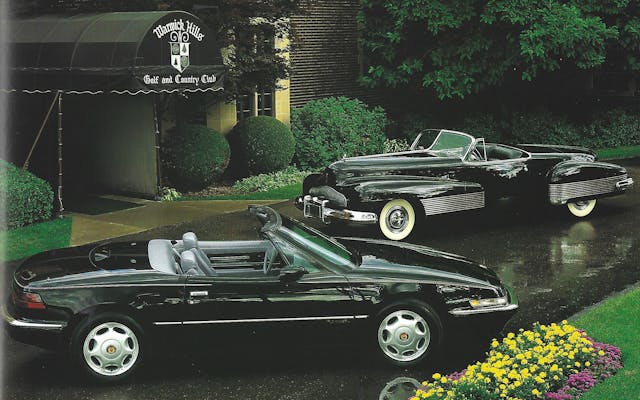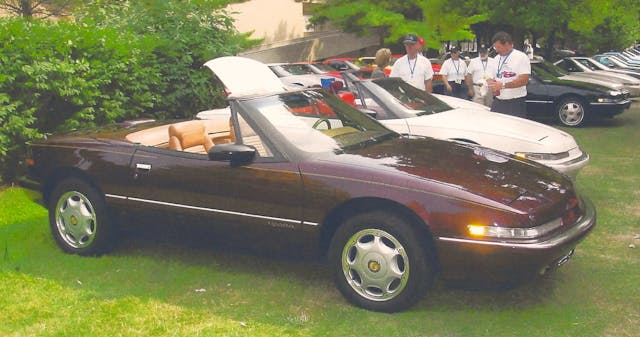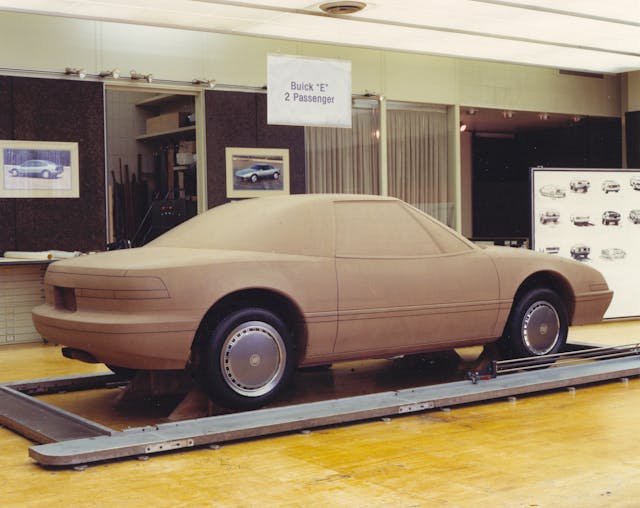The Cool Car Chronicles: My Life and Times with the Buick Reatta
Four years before I acquired a Reatta, I found myself planning and executing the magazine press preview event for that very nice yet largely unappreciated Buick two-seater. In 1987, after eight years as an auto engineer with Chevrolet and GM—interrupted by three years of U.S. Navy service—and 14 as a busy auto writer, I had accepted an offer to establish and run a western-area PR and media relations office for GM’s Buick Motor Division.
I had never done or trained for PR or event management but had attended countless such events as media, and it helped greatly to be married to a highly effective auto PR pro. Using my media experience and her as a role model, I felt I could learn the job fairly quickly and do it reasonably well. And I arrived in that new job just in time to plan and execute that important press event to kick off the media launch of Buick’s first-ever two-seat sporty coupe.
My Reatta

But my Reatta ownership began more than four years later, soon after the car had been killed for lack of sales and negative profit. Buick had made substantial improvements to it for ’91, including an upgraded, 170-hp “Tuned Port Injection” 3800 V-6 coupled to an electronically controlled four-speed automatic, plus larger wheels and tires, a console cupholder, and, for the convertible, anti-shake add-ons and a power pull-down for the (previously manual) top.
But, as usual for GM of the 1980s and ’90s, those improvements came too late, and on March 5 of that year, GM president Lloyd Reuss—who had fathered the Reatta first as Buick chief engineer then as general manager—announced that it was canceled and would be replaced at the Lansing Craft Centre by a sophisticated electric vehicle. Just 1520 Reattas were built for 1991—305 of which were convertibles.

And because the ragtop Reatta introduced for ’90 had been plagued by a troubling amount of body shake due to its Riviera-based platform’s lack of structural stiffness, Buick engineers tested those 305 somewhat strengthened ’91 convertibles for shake on a variety of surfaces and divided them into three groups based on the results. Those testing good enough for public sale were shipped to dealers; those (62 cars) judged too shaky for anyone were scrapped; and the middle group of 115 were offered for sale to employees at a friendly price.
In my role as the western PR guy, I had driven Reattas often since the car’s 1988 launch, loaned them to media for (mostly good) reviews, demonstrated and defended their unique and highly capable—but slow and complex—TV-like cathode-ray tube (CRT) infotainment system and the ’90 convertible’s manual top, which could be lowered and raised quickly and easily once you knew how to do it. And I really liked the car for its handsome look, its pleasing dynamics, and the positive public reactions it earned in car-crazy California.



So, I applied to purchase one of those shake-tested, “good enough for employees” ’91 convertibles and was thrilled to be offered one of just 13 that had been built in a beautiful Claret Red color. And because that opportunity arrived when I was preparing to transfer from Buick back to the engineering side as vehicle test and development manager for GM’s start-up electric vehicle group, I was able to drive that beauty as my company car for its first three months, then purchase it at a substantial discount. That GM EV group evolved into its Advanced Technology Vehicles (ATV) division and, eventually, after a long delay while GM nearly went bankrupt in 1992–93, produced the technologically brilliant but poor-selling EV1 battery electric coupe in that very same Lansing Craft Centre.
First Taste
Actually, my first taste of Reatta happened nearly a year before its public introduction. Buick PR ace (and historian) Larry Gustin had invited me and then-Motor Trend editor Tony Swan to Phoenix for an off-the-record sneak peak of the soon-to-come two-seater. They wanted our feedback, so we drove pre-production examples and provided our opinions.
We were unsure of what to expect. To properly fit the Buick mold, it would probably not be a muscular Corvette or high-zoot Cadillac Allanté competitor but likely a softer, plusher, slower, less exotic, and more affordable car than both. We were right on all counts . . . and pleasantly surprised by how much we liked it, beginning with its appealing good looks. And we found it more agile and better glued to the road than any Buick before it. On the other hand, we were disappointed by its complex CRT-dominated dash and the middling performance of its 165-hp V-6, both inherited from the ’86 Riviera on which it was based.
I hadn’t thought of that day as a job interview, but it may have been so at least partially, since it wasn’t much later that I was offered the PR opportunity. And, after spending the last 12 of my 14 auto-writing years as a hard-working self-employed freelancer, I was more than ready for a real job with real benefits, even if it meant going back to the corporate side.

Then, in planning the media preview, I figured the Reatta—essentially a shorter, lighter take on the Riviera’s “personal luxury” coupe platform, which offered a good-handling T-Type model—would please the writers on curvy California two-lanes but would be down on power on uphill stretches. So, I based the event up the coast from LA in lovely Santa Barbara, then invested considerable time exploring the roads around there and carefully selecting those that would best let our Reatta press cars shine. Creating that drive route was the fun part; the rest was hard work. But the event went well, and we got mostly good reviews.
As I have written here before, Buick’s sporty two-seater was conceived more than a decade before its birth, primarily by then-chief engineer Lloyd Reuss. It was proposed in 1980 by Reuss (by then Buick’s general manager), product planning chief Jay Qualman, and strategic planning manager Lynn Salata. Their plan to base it on a shortened front-drive “E-car” (Riviera/Olds Toronado/Cadillac Eldorado) platform and powertrain would keep its investment costs down.

Originally intended for a 1983 launch as an ‘84 model, the Reatta was delayed more than four years by the complex reorganization that folded GM’s five divisional marketing and engineering divisions into Buick-Oldsmobile-Cadillac (BOC) and Chevrolet-Pontiac-Canada (CPC) “super groups.” There were also engineering resource constraints, plus an agreement to let Cadillac get its own two-seat Allanté done first. Then, when it was finally ready for a January 1988 public launch, our PR challenge was to help media understand this very different new Buick was neither a Corvette nor an Allanté competitor and hope they would write kind words about it.
At $25,000, the Reatta was pricier than intended partly because E-body componentry had inflated in cost, but it also boasted nearly every conceivable feature as standard equipment. The only options were a power sunroof and a 16-way power driver’s seat. Just 4707 were built for 1988, and 7009 for 1989, as the price inflated to $26,700 and sales slowed as initial demand was satisfied.


Nineteen-ninety brought a much-improved instrument panel with electronic analogue gauges replacing the CRT. It also gave us the long-awaited convertible. Because the E-body had not been designed to have its top removed, it had taken nearly two additional years to engineer more strength into the shortened (by 9.5 in.) ragtop Reatta’s structure. The convertible drew media raves for its beauty and character but brickbats for its somewhat shaky body and its manual top, a complex design that narrowed in width as it dropped into a well under a hard tonneau cover. Other changes included the addition of a power steering cooler and a driver’s side air bag.
That was the Reatta’s biggest production year, with 6383 coupes and 2132 convertibles assembled by teams at the Lansing Craft Centre. But Buick’s upscale two-seater was proving a difficult sell in a soft market unkind to impractical image cars in general. It was also a major money loser given its high cost, low volume, and dedicated plant. Still, it got another price increase, to $28,335 for the coupe and a whopping $34,995 for the convertible. The four-year production total after the curtailed 1991 model year was 21,750—19,314 coupes and 2437 convertibles.

I loved my pretty dark-red Reatta convertible and kept it for many years—stored in a farmer’s barn beside the ’67 Corvette my wife and I had bought in 1990—as a pleasing occasional driver, top-down when possible, and a potential future collector car. But I eventually needed the money so had to sell it.
Buick’s Reatta was a finely styled, fully equipped, delightful-to-drive, two-seat sporty car (with a real, usable trunk) that was narrowly targeted at a select group of buyers with discretionary income. It was also widely misunderstood. Some expected a Buick “Corvette.” Others, a lighter, less expensive sports car than it was. In reality, it was a half-price Mercedes SL (or Cadillac Allanté) luxury tourer with no direct competitor save the dismal and short-lived Chrysler TC by Maserati. It was another very cool car I would love to have back one day, but in the same pristine condition it was in when I reluctantly parted ways with it.






These were nice little cars. If it had only been a RWD I can imagine it would have sold better.
Think of the things they could have done. A Turbo or even SC version with a performance suspension would have been interesting.
Even at that I liked these and they are still affordable if you do not need the more rare parts like a touch screen some came with.
A RWD and SC option would have been fun for these cars. i remember when Buick was telling us how cool their touchscreen was with it was either a CD or floppy based program to interact with. It was an interesting computer program.
I do not understand why so many of us over a certain age think that RWD is automatically better. I doubt if even 5% of the potential buyers for a Reatta-style car would care about RWD; as the article pointed out, it was not a Corvette-competitor. My dad was a lifelong “Buick man”, and when he traded his 1976 Regal coupe for a 1987 LeSabre coupe, he was very pleased with the superior winter traction. And his LeSabre, equipped with the Gran Touring package, handled quite well.
Have an 89 allante and had an 89 reatta. The Allante is leaps and bounds better in every way than the reatta, at least comparing 89s. I was pretty underwhelmed by the Reatta and sold it fairly quickly. That said, I still think they are special cars and they look much, much better as convertibles. I really wish they had been designed as convertible from day one. I would consider another one at some point if it was a 91, and I do like your color. The larger, redesigned wheels and upgraded V6 help it too. Considering the product delays of the day, it’s too bad the Reatta actually wasn’t launched closer to the 91 full line renaissance that GM was about to undergo which created some of the coolest, most underappreciated designs in the last 50 years in my opinion ( still on my top 100 cars would be a 91 Oldsmobile Touring sedan in blue, or the same red as your retta)
Have 1990 with less the 9000 miles on (convertible ) it’s black !! Thank you for great article.
We have a 1990 reatta having driven it sent 2009 been parked in the garage need a little work but it is a nice car my wife drove it all the time it is red I am going to sale it getting to old to work on it
Have a white 1991 convertible with tan top and tan interior. 47000 miles and has never seen anything but Sunshine. Love the car! Really a Nice car to cruise in on summer evenings.
I always liked the look of the Reatta, even more so than the contemporary Allante (which I also kind of liked); and I’m not one to normally like small cars. I had read about the Reatta, and it’s a pity it was discontinued, especially in favor of an overhyped concept that is still overhyped and overrated 30+ years later. On the other hand, cars with confused identities usually do not last long (the Thunderbird being the sole inexplicable exception), and that was a sad truth about the Reatta: It was too sluggish to run with ‘Vettes, too elaborate to run with Miatas, and too middle-class to run with Allantes or Benz SLs. It certainly was not “your father’s Buick”; but it wasn’t your mother’s, either; nor was it really a car for many sons and daughters. More’s the pity, because it was one of the best-looking designs GM came up with in the ’80s. I would have one if I could.
Reatta’s are useless junk just like fiero’s. Wake up.
Perhaps refine your grammar. Your attitude might follow?
Thumbs up on that one, Raf.
Apostrophe abuse is such a wonderful thing!
I worked at a Buick store when the Reatta came out. It generated a lot of interest. IIRC, the rollout promised (and may have included pictures of) a convertible, and many of our customers came in for the droptop, only to be told “it’s not out yet, but it’s coming soon.” Many deferred their purchase until the drop top hit the showroom.
But the rollout kept getting pushed back and two years was just too long for most people. We did sell some coupes with the promise of a “special” trade-in price if that customer came back and traded their coupe for a convertible.
In a nutshell, it was a car that promised a lot but just didn’t meet expectations, and the improvements GM made were too little, too late.
Wow Greg.
Way to support people liking things other than what you like.
I’d happily clear space out for a last Gen Fiero GT, an Allante, or a Reatta.
There’s an Allante in my family that will sit next to a handful of British, German, French, and 50s/60s GM sports and muscle cars. Oh, and the GMC RV.
The Reatta would fit in nicely. I’d need a new wife if I bought another car, but.. It’s a unique car.
Something GM rarely can claim to make anymore.
You had…lost me…at “good enough”.
My ’88 still starts as soon as I turn the key, only car that’s ever done that. It seriously explodes into life. It’s got over 250,000 km but the beautiful dash and CRT work intermittently so real mileage is unknown. It’s a nice drive except that the heat comes on when the dash doesn’t work, making a trip to the beer store in July something like sitting in a sauna.
The ’92 Cutlass Supreme I learned to drive on did that, too! I don’t know how or why the automatic system defaulted to full hot, full fan when the display was inoperative, and you’re the first person I’ve come across who feels my pain.
And I’m the second. My ’90 Olds Trofeo did the same thing toward after about 120k miles, although the tachometer and CRT still worked. Never did find out why.
I had a 88 Reatta. It must have been built on a Friday or Monday by drunk guys, nothing but trouble got rid within a year.
Roger that! I admired the design but never owned one. Because I do all my own work including making parts from scratch, but I hate electrical troubles. And a car with hundreds of pounds of electronics that uses MULTIPLEXED wiring likely cannot be fixed with enthusiasm, a shop manual and a VOM. At least not by me and possibly by Buick service personnel.
Tons of electrical problems as they age vs there value. Eventually had mine towed for junk. Potentials?!?
The convertibles were attractive designs, but the coupes did not look so great to me. The Reatta seemed overpriced at the time, although the article gives some insight as to why. Personally, at this point in time, I would rather have a 2002-2005 Thunderbird, although they can have a few issues, also.
I would not call the Chrysler TC “dismal”, but to each his/her own.
In the 80’s and 90’s I was a “shop instructor” for the Automotive Technology program and the local community college.
In an effort to bring in an everlasting supply of vehicles for the students to practice their skills we took in customer work mainly from students, staff, friends of friends, etc. We made a small mark up on parts and didn’t charge for labor but things took awhile to get done as the students weren’t there all day. This was fine with our clientele but also led to the program “inheriting” the occasional “alligator car” that had already eaten up several shops in town due to the customer/shop time = money continuum and still wasn’t repaired.
That’s how we ended up working on a Reatta with the CRT dash that had “gauges” that were there one minute and gone the next. It took weeks of on and off work and ideas but we finally fixed it, at least it was all working consistently when it left, by carefully removing each wire (one at a time) from the large, multi-wire connector for the instrument cluster and re-tensioning each female connector so there would be a secure electrical connection when the two halves of the connection were rejoined.